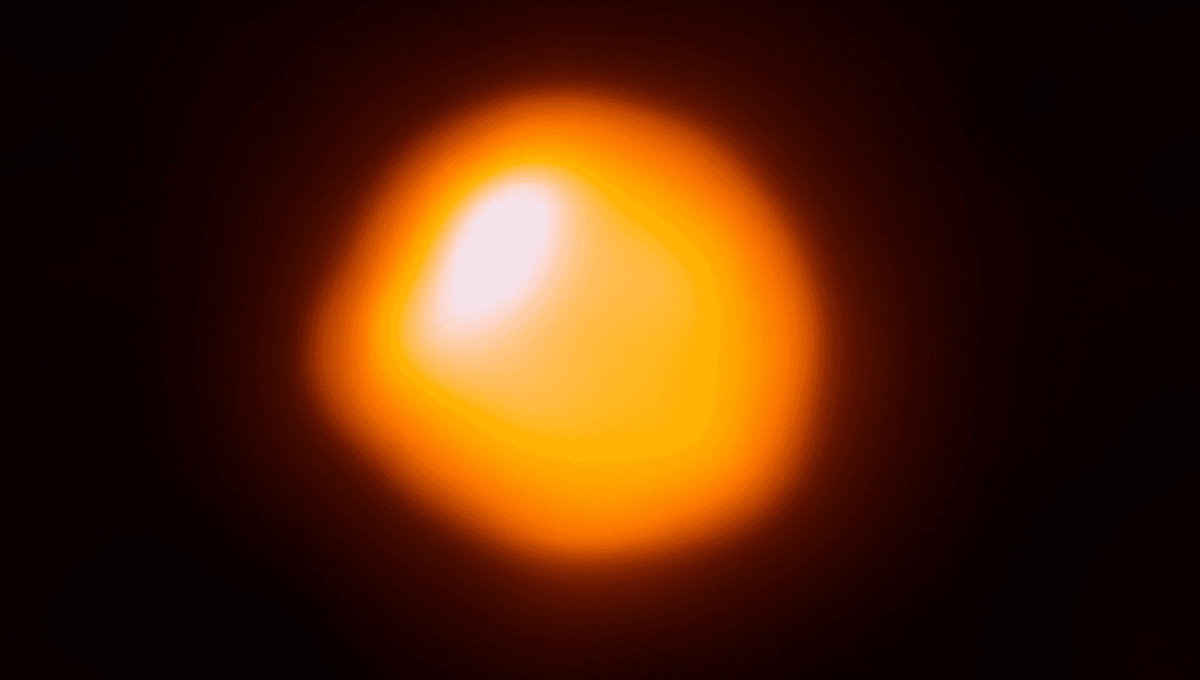
If you saw Orion before it disappeared behind the Sun this year, you may have noticed Betelgeuse’s unusual brightness. Astronomers are unsure of what to make of this brightening, but one team has reinterpreted long-standing patterns in its variability to conclude it is not only in the carbon-burning stage of its life, but nearing that phase’s end. If so, the nearby red giant could pass through the subsequent stages of its life in a few decades and explode in the lifetime of people reading this article.
There is no doubt that Betelgeuse, as a highly evolved red supergiant, will some day become a core collapse supernova, creating a light similar in brightness to the full Moon. Although we know that this will be soon by astronomical standards, it’s much more debated whether it deserves the same description on human timelines.
The conventional view is, Betelgeuse will not blow its top for around 100,000 years; frustrating thousands of generations of astronomers until then. Some evidence suggests it’s more like a million. However, the preprint of a paper submitted to Monthly Notices of the Royal Astronomical Society, but yet to complete peer review, reaches a quite different conclusion.
All stars start off fusing hydrogen atoms into helium, and do this for the bulk of their lives. Eventually, they run out of hydrogen in their core and start turning helium into carbon there, although hydrogen fusion can continue for some time further out. Carbon subsequently gets turned to neon, sodium, and magnesium, a process known as carbon-burning even though it has nothing in common with the chemical process where atoms undergo ignition in oxygen.
Supernova explosions occur only after successive rounds of neon, oxygen, and silicon fusing, so to estimate the time until Betelgeuse’s big day we need to know what stage it’s at. In the preprint, Dr Hideyuki Saio of Tohoku University and co-authors argue Betelgeuse is not only burning carbon, but starting to run out.
Like other stars nearing the end of their lives, Betelgeuse pulses, causing it to swell and shrink with accompanying changes in brightness. Regular cycles of 185, 230, 420, and 2,200 days have been tracked, in addition to other less predictable variations. The great dimming of 2019-20 was partly caused by an outburst of dust, but also involved the troughs of several cycles coinciding.
The paper’s case rests on the question of which of the pulsation periods is the radial fundamental mode (RFM), whose period is intrinsically related to the radius of the star. If, as the authors argue, the RFM is the 2,200-day cycle, not the 420-day cycle as others believe, then Betelgeuse must be even bigger than we thought. For a star of its mass, such a size – probably around 1,300 times the radius of the Sun – would indicate it is near the end of its carbon-burning phase.
Once the carbon-burning phase finishes, the end is a matter of a few decades away. The authors state that it is not possible to tell quite how close Betelgeuse is to fusing the last of its carbon, but being late in the game to a process that lasts a few thousand years suggests there can’t be long to go.
It might seem that settling the debate about Betelguese’s size would be easy, but there is considerable uncertainty about its distance. It has proven surprisingly hard to establish if it is a very big star 530 lightyears from Earth, or an absolutely giant one 900 lightyears away.
Supernovas can cause great damage to planets in their galactic neighborhood and have been considered possible causes of past extinction events. However, even at the closest estimate, Betelgeuse should be far enough away to not do any damage, while still giving us a front-row view of possibly the galaxy’s first supernova since 1604. The only thing we have to fear is missing out on an epic fireworks display.
The study has been submitted to Monthly Notices of the Royal Astronomical Society and is currently available on ArXiv.org.
Source Link: Betelgeuse’s Pulsations Suggest Its Explosion Is Not Far Off